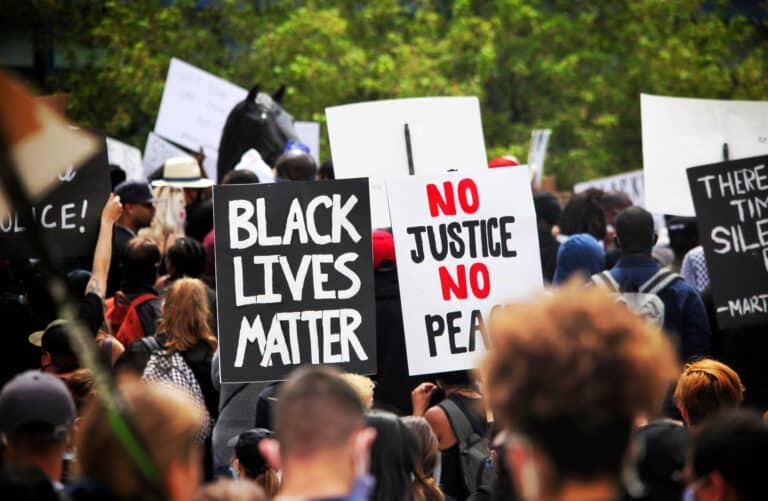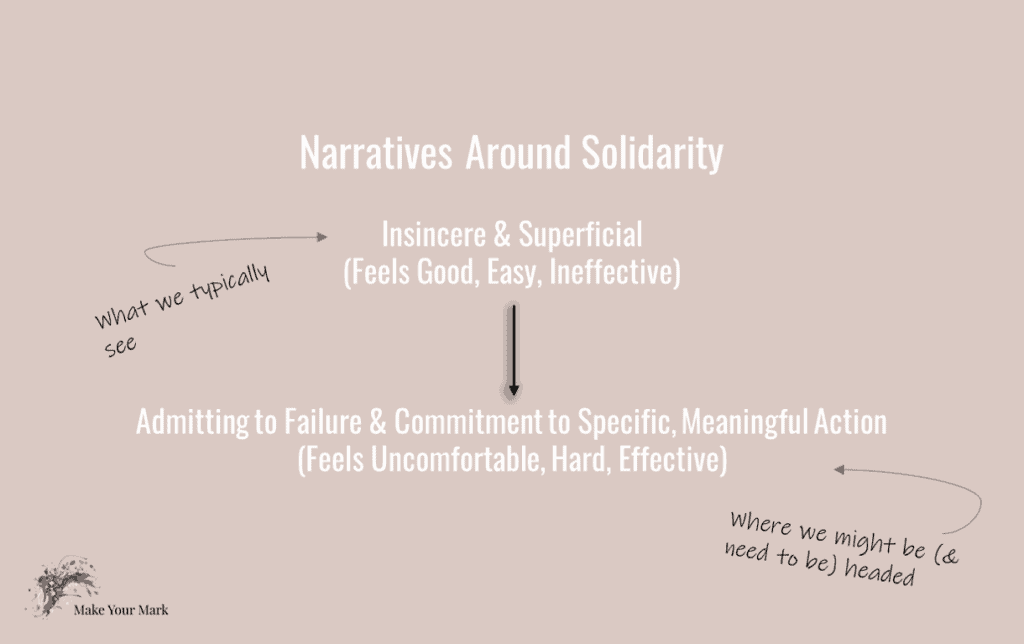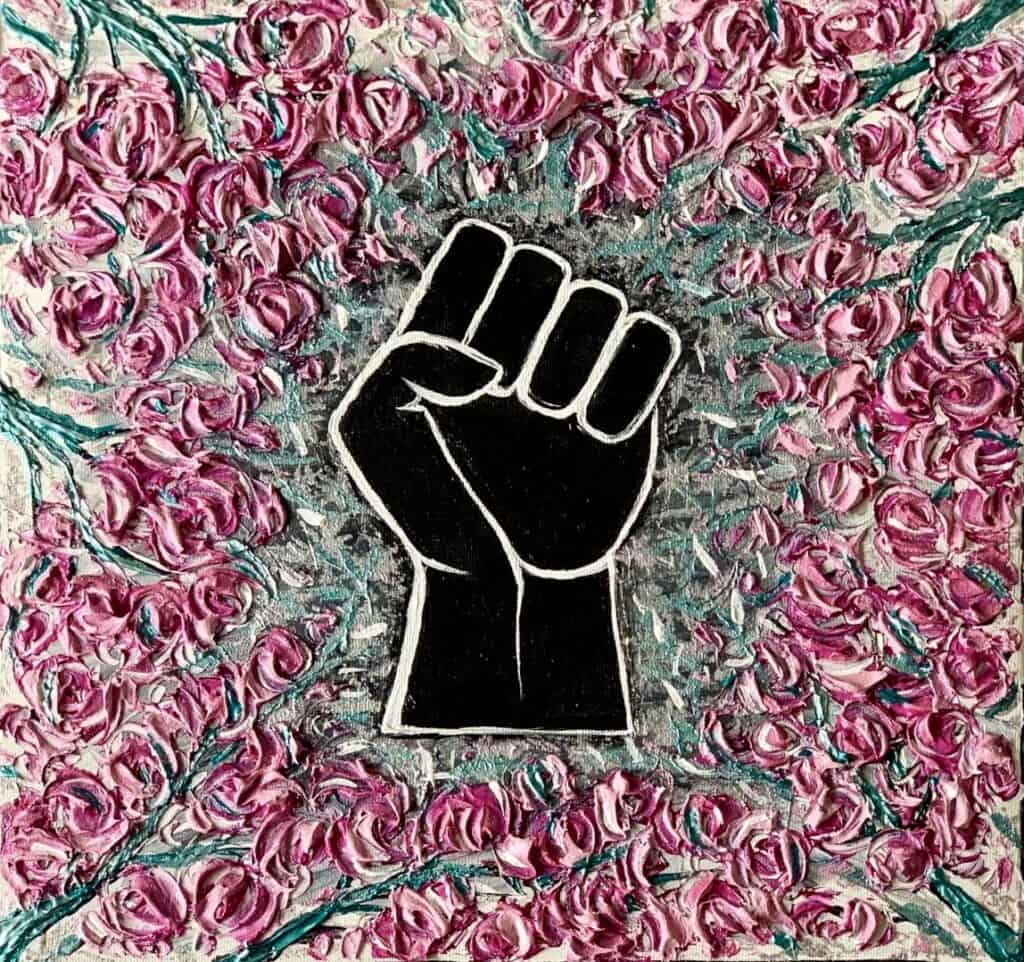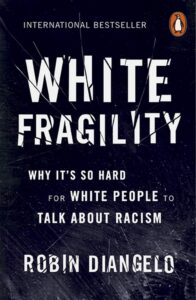Photo of original painting by Nada Khatib
On May 26, 2020, the Black Lives Matter movement took to the streets yet again to protest police brutality and systemic racism, sparked by the horrendous murders of George Floyd, Breonna Taylor and Ahmaud Arbery.
The movement has ignited protests across the United States, Canada, and all throughout the world.
There is a sense that this time is different, and the scale much greater.
In part, it feels different because the urgency of the message is taking hold across racial lines, at an unprecedented volume. White people, and the organizations led by them, seem to be emerging from a privilege-induced coma with a desire to engage.

However, many from the Black community are making it clear that it’s not just about showing up, it’s about how you show up.
Performative activism or performative allyship – when those outside the marginalized group take on a superficial role of ally – are likely terms you hadn’t heard until a few weeks ago.
Now, as a direct result of the Black Lives Matters movement, the terms have caught fire. They are being used to concisely pinpoint insincere, and at times harmful, representations of support.
The focus on the narrative of authentic solidarity, at a time when so many people are paying attention, actually gives me hope.
The terms often come up in articles about the narrative surrounding authentic solidarity. They raise important questions that need to be examined on a personal and organizational level:
- What do statements representing authentic solidarity look like?
- Are these statements altruistic or are they tied to self-interest?
- Will these statements actually lead to meaningful change?
Articles addressing these questions are cropping up daily. You could interpret this as a disappointment: another sign that there is so much work to do.
And that is true (and nothing to be surprised by), but the degree of focus on the narrative of authentic solidarity, at a time when so many people are paying attention, actually gives me hope.
In this post, I’ll explain why narrative matters, how White people and the organizations they lead can help shift the narrative, and how they’ll know if they’re on the right track.
Not because it hasn’t been said, but because it’s worth re-iterating as many times as it takes.
Why Narrative Matters
The unprecedented volume of interest in the Black Lives Matter movement, alongside a considerable focus on the narrative of solidarity, could lead to transformational change on a mass scale.
Transformational change happens by shifting mental models, the deeply held beliefs about how the world works, and the narratives that inform, and are informed-by, those mental models.
Why is this important?
Transformational change has the power to considerably influence the other layers of systemic change.
That is, it heavily influences structural (policies and practices) and relational (power dynamics and relationships) change. As written by John Kania, et al, “unless [we] can learn to work at this third level, changes in the other two levels will, at best, be temporary or incomplete”.
Changing the narrative is critical because narrative – and the beliefs and values that inform it – drives action.
A recent article in Stanford Social Innovation Review (SSIR) by Kristen Grimm, for example, points out how the narrative around the Great Recession – that poor people were in over their heads – laid the groundwork for “bank bailouts and unchecked power in the financial industry”.
Since the Black Lives Matter movement emerged in 2013, it has already significantly influenced the narrative surrounding police brutality against Black people.
On a large scale, people began to realize that police brutality against Black people as both prevalent and deplorable.
This, in turn, led to structural changes, such as body cameras and mental health crisis response training.
In other words, changing the narrative is critical because narrative – and the beliefs and values informing narrative – drives action.
The Typical Narrative Around Solidarity Maintains the Status Quo
Members of the Black community have expressed gratitude for the organizations and White individuals who have stated their support for the Black Lives Matter movement.
But they’ve also said that many of these statements are falling short.
While the statements may stem from a genuine sense of compassion, too often they do nothing to shake up the status quo.
There are two fundamental problems with the narrative surrounding them. Below, I link to the (mostly) Black authors and activists, as the experts in this, that have pointed out how the typical narrative around solidarity fails to bring about change.
1) It Is Insincere (aka Performative Allyship)
Social media makes it easier than ever to jump on the bandwagon with just a few characters, a hash tag, or even a blank black screen as per #blackouttuesday.
Sure, these surface-level displays of support may help scale the message, but they do little to bring about concrete change.
People in the Black community, such as Holliday Phillips, are saying: “You’re here now, but where are you the other 364 days a year when anti-racism isn’t trending?”
And while many may have taken time and thought to craft their statements, they still fail to acknowledge how the people standing behind them have contributed to the problem.
Tre Johnson, aptly wrote in The Washington Post, “making up for past wrongs means starting with the fact that you’ve done wrong in the past, perhaps without realizing it at the time.”
Systemic racism wouldn’t be nearly as rampant as it is if the number of organizations saying they won’t stand for it, hadn’t.
Company statements may even highlight their diversity initiatives, or how they have “always” supported diversity and would “never” tolerate discrimination.
The fashion and fast-food industry provide just a few examples of companies co-opting the movement for their own benefit through statements like these.
Sadly, there are very few organizations that would be able to say, “no bias here”.
The fact is, systemic racism wouldn’t be nearly as rampant as it is if the number of organizations saying they won’t stand for it, hadn’t.
Foundations and non-profits may be especially hesitant to admit they need to re-examine their own policies and practices.
Their brand is built on the idea that they are the leaders of social progress – if donors can’t trust them to fill this role, why would they give to them?
On the other hand, perhaps this is all the more reason to model what leadership looks like.
In this case, leadership means admitting failure and committing to action, which brings me to the second fundamental problem with the typical narrative.
2) It Doesn’t Commit to Action
Members of the Black community are emphasizing that words are not enough. It is action that is needed.
See, for example, Senior Contributor, Janice Gassam’s article in Forbes titled, “Dear Companies: Your BLM Posts Are Cute But We Want To See Policy Change”.
If organizations aren’t ready to commit to action, Chuka Umunna stated in Forbes, they might as well refrain from making any statement at all:
“There is no point making any comment on the outrage of Floyd’s killing and in support of the Black Lives Matter movement unless the whole of the board and senior executive team subscribe to the sentiment and want to do something about it, because without their buy-in, change is unlikely to happen.”
Anthony Morgan, a racial justice lawyer and manager of the Confronting Anti-Black Racism Unit with the City of Toronto, put it frankly on a recent episode of CBC’s The Current, “we want substance of your commitment. What are you actually willing to invest, to give up to support the achievement of equitable well-being for black people?”
Authentic solidarity will threaten personal self-efficacy, organizational stability, the short-term bottom line, and long-term priorities. But that's what it will take to dismantle racism.
Shifting the Narrative: How You’ll Know You’re Embodying Authentic Solidarity
In case it’s not already clear, this article is aimed at a White audience. In this next section, I’ll address this group directly.
Perhaps after reading this and other articles like it, you will say, “No, that’s not what we did. Our statement of support is sincere and tied to concrete action”.
You might hope that, with that, you are successfully in tune with what Black, Indigenous and People of Colour have been calling for.
Not so fast.
The litmus test is this: how does it feel in your gut to make these statements?
Inauthentic solidarity feels quite comfortable, good even, and it’s actually quite effortless.
But authentic solidarity is hard, because it’s really, really uncomfortable.
Why?
It’s uncomfortable because there are at least 4 ways authentic solidarity will threaten your self-efficacy, organizational stability, short-term bottom-line, and long-term priorities.

4 Pathways to Authentic Solidarity
1) Confront your inner racist
In White Fragility, Robin DiAngelo argues that all White people, herself included, have a racist worldview and biases they may not even be aware of.
This is really hard for people, especially those who consider themselves to be left-leaning or even mildly socially conscious.
It’s also hard because it takes a lot of deep work to unlearn internalized ways of looking at the world, and what it would mean to give up the privilege you’ve taken for granted all these years.
Similarly, it’s hard to hear it when, at some point or another, your attempt to be anti-racist failed.
Over the last few weeks, there are several examples of people and organizations that tried to show their support and later apologized, because in reality their remarks were insensitive.
This process – try, fail, learn, and correct – is something we will need to accept. Defensiveness, or guilt that silences, will not help us grow.
2) Examine how your organization’s policies and practices have maintained racism and inequity
For those in positions of leadership, this is almost as difficult as the first. You may have a tendency to point to your diversity officer, or your record of charitable donations as proof of your inclusivity.
However, you must also look at how well Black, Indigenous and People of Colour are represented in your organization.
This should be examined at every level, including your Board, your executive team, managerial and so forth.
You must also examine how your policies, practices, norms and routines keep White privilege unchecked and perpetuate systemic racism within and outside of your organization.
Acknowledge it outright, and change it.
If you are involved in grant-making, you must also examine how your funding practices may contribute to systemic racism. Cheryl Dorsey et al in SSIR’s “Overcoming Racial Bias in Philanthropic Funding”, explains:
“Racial bias—both personal and institutional, conscious and unconscious—creeps into all parts of the philanthropic and grant-making process. The result is that nonprofit organizations led by people of color receive less money than those led by whites, and philanthropy ends up reinforcing the very social ills it says it is trying to overcome.”
Authentic solidarity means investing in anti-racism well-beyond this string of demonstrations. Embed this work as an organizational priority for the long-haul.
3) Pay for the costs associated with properly examining and correcting your mistakes
If you are a leader in an organization, authentic solidarity might cost you money (and not in the form of a taxable donation).
Donations are easy, and they feel really good. Important yes, but they’re not as effective as structural change.
Introducing pay equity, or hiring experts to help you revise your policies and practices, on the other hand, might require a hefty investment if you’re willing to do it well.
Yes, there is significant evidence to say there are financial benefits to becoming a more diverse, anti-racist, anti-oppressive workplace. However, I will spare the overview of these benefits because this is a moral and ethical imperative, not a financial one.
4) Commit to the work well-beyond the buzz
At the moment, the Black Lives Matter movement is front and centre. Trendy, even. But like every other news story, interest will fade, and the media’s attention will go elsewhere.
Authentic solidarity, however, means investing in anti-racism well-beyond this string of demonstrations. Embed this work as an organizational priority for the long-haul.
Narrative drives the quality of our actions. And concerted action on a mass scale is the only way to achieve the structural and relational change necessary to truly dismantle systemic racism.
Final Thoughts
So, before you write your next statement of support, pay attention to how you’re feeling.
Measuring how uncomfortable you are is a good way to test the integrity of your statements. Obviously, follow-through will be the best measure.
But for starters, how uncomfortable is your leadership team, or your White employees? How uncomfortable is your Board?
Those truly committed to the cause will lean into this vulnerability. They will put themselves out there, learn, and try again.
The 2020 BLM movement is shifting the narrative around solidarity—from insincere and superficial, to admitting failure and committing to action. If enough people and organizations can get behind this shift, maybe there is hope.
Because narrative drives the quality of our actions. And concerted action on a mass scale is the only way to achieve the structural and relational change necessary to truly dismantle systemic racism.




Thanks for being so thoughtful Charla
No need to thank me! 🙂
Thanks for helping me understand why so many protests do not morph into action!
Also makes me wonder “Why are people with racists attitudes so comfortable with themselves, but I am not comfortable standing against them?”
I’m not an expert on this, but sometimes people are so comfortable saying a racist remark because they don’t even realize their perspective is racist. Often, people aren’t necessarily trying to be hurtful. That’s why it’s so important for all of us, especially White people, to continuously check our privilege. I had to do it continuously even writing this article. But a lot of times, people’s comments are micro-aggressions, subtle forms of racism that have a huge impact on People of Colour. It’s hard to call it out because people react very defensively for a number of reasons (refer back to the book White Fragility for more on this). Regardless of where people are coming from though, mastering the art of an effective response takes practice. Try countering with “micro-interventions”: avoid leading with “that was racist”, but instead ask questions that challenge their assumptions, and use a story to illustrate a different perspective, or make a point about generalizations being unhelpful/ inaccurate.